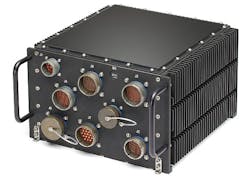Northrop Grumman details VME-based flight computers on Marine Corps combat helicopters
Northrop Grumman will deliver 119 of the company's FlightPro Gen III mission computers, which integrate advanced mission, weapons and video processing capabilities into a conduction-cooled, high-performance airborne computer, company officials announced this week.
Contract administrators at the Naval Air Systems Command at Patuxent River Naval Air Station, Md., announced the contract to Northrop Grumman on 28 May 2014 as part of the Marine Corps H-1 helicopter upgrade program.
Northrop Grumman will provide identical Gen II mission computers for the UH-1Y and AH-1Z aircraft that make up the Marine light attack helicopter squadrons to help save money and simplify logistics.
Related: Flight computers for Marine Corps helicopter upgrades to come from Northrop Grumman
The embedded computing systems are part of the Navy's H-1 upgrade program to refresh technology aboard the Marine Corps Bell UH-1Y Super Huey utility helicopter and AH-1Z Super Cobra attack helicopter. Northrop Grumman is doing the work in Woodland Hills, Calif; Salt Lake City; and Baltimore.
The FlightPro Gen III mission computers incorporates a ruggedized 6U VME PowerPC-based single board computer. FlightPro interfaces include Fast Ethernet, four serial ports, parallel I/O, and built-in-test. FlightPro has a standard, partitioned real-time operating system with ARINC 653 and POSIX support.
The standard configuration also includes a quad channel 1553 mezzanine card, high-speed serial card, digital I/O module with eight channels of opto-coupled discrete inputs, eight channels of opto-coupled discrete outputs, and 16 channels of general-purpose bi-directional discretes that can be programmed individually as outputs or inputs.
Related: Curtiss-Wright to provide embedded computing for Army UH-60V helicopter avionics
FlightPro is capable of Required Navigation Performance/Area Navigation (RNP/RNAV) in all flight regimes, including departure, en route, terminal and non-precision approach using GPS as the sole navigation source.
Containment integrity is continuously selectable from RNP-20 for oceanic/remote airspace down to RNP 0.3 for approach legs and advanced cockpit display formats are provided to support this capability. This permits the crew a real-time view of the entire flight plan and current progress, including all flight legs and navigation waypoints.
The flight computers use 28-volt DC or 115-volt AC three-phase 400 Hz input power, measure 13.61 by 11.5 by 7.55 inches, and weigh 30.4 pounds. The computers have rated 3,200 hours mean time between failures.
The flight computer software is RTCA DO-178C compliant, has ARINC-653 partitioning for safety and security, and complies with the Modular Open Systems Architecture (MOSA) standard. The software is aligned with the Future Airborne Capability Environment (FACE) technical standard, has hardware-independent application software developed to MIL-STD-498, under MIL-STD-882C safety program environmental qualification.
Flight computer hardware is designed to MIL-STD-461D for electro-magnetic compatibility, and is tested to MIL-STD-462 and MIL-STD 810E. FlightPro is conduction cooled, and represents “Quiet Cockpit Technology,” Northrop Grumman officials say.
Dual mission computers are the heart of Northrop Grumman's Integrated Avionics System (IAS) that powers the glass cockpits of the Super Cobra and Super Huey helicopters, Northrop Grumman officials explain. The mission computers provide centralized control of the IAS and display situational awareness and health monitoring information.
Related: Navy moves forward on helicopter-based EW to protect surface warships from missiles
Additionally, the IAS and mission computers feature open, modular architectures to accommodate future system upgrades; rapid insertion of new technologies; and integration of other avionics, communications, and survivability equipment. Northrop Grumman also provides the operational flight program software that controls the IAS.
"The FlightPro Gen III mission computer has the latest computing technology and increased processing resources to improve situational awareness and lighten warfighter workloads," says Ike Song, vice president of the situational awareness systems business unit at Northrop Grumman Electronic Systems.
The H-1 Upgrade program is replacing aging AH-1W and UH-1N helicopters with upgraded UH-1Y and AH-1Z aircraft to enhance commonality, reliability, and maintainability. The upgraded helicopters have 100 percent software commonality through Northrop Grumman's IAS and the same operational flight program.
For more information contact Northrop Grumman Electronic Systems online at www.es.northropgrumman.com, or Naval Air Systems Command at www.navair.navy.mil.
About the Author
John Keller
Editor-in-Chief
John Keller is the Editor-in-Chief, Military & Aerospace Electronics Magazine--provides extensive coverage and analysis of enabling electronics and optoelectronic technologies in military, space and commercial aviation applications. John has been a member of the Military & Aerospace Electronics staff since 1989 and chief editor since 1995.
